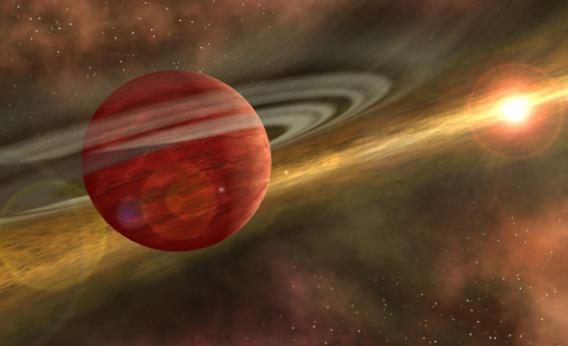Create a free profile to get unlimited access to exclusive videos, sweepstakes, and more!
How the Heck Did This Exoplanet Get Where It Is?

Remember just the other day when I wrote that most planets orbiting other stars are found indirectly, and getting a direct picture of one is really rare?
Yeah, about that: Another one was just announced. Yay!
The planet is called HD 106906 b, and itâs about 11 times the mass of Jupiter. It orbits a star hotter and more massive than the Sun (for the astrogeeks: an F5V star with 1.5 times the mass of the Sun) thatâs about 300 light years from Earth. As I pointed out in the other article, these planets are easier to find in the infrared when they are young and hot; the star and planet are only about 13 million years old â compare that to the age of the Earth, which is 4.56 billion years â and the planet was seen using the Magellan telescope in Chile, using an infrared detector.
Like the other three recently announced, HD 106906 b was confirmed as a planet because it is moving in the sky along with its parent star. If it were a background star or galaxy, the star would zip past it over the course of several years. Using earlier images from Hubble and the Gemini telescopes, the object was found to keep in step with the starâs motion. Therefore it must be a planet bound to the star.
Incredibly, though, itâs really far out from the star: 650 times the distance of the Earth to the Sun, or about 100 billion kilometers (60 billion miles). Thatâs an astonishing distance! Even Neptune orbits the Sun at 1/20th of that separation.
Thatâs actually a bit of a problem. We think planets form from a disk of material that swirls around a star as itâs born. But those disks donât usually reach out anywhere near that far, leaving us with a mystery. As it happens, many stars form in clusters, collapsing out of knots of gas and dust in much bigger clouds. Itâs possible this object formed that way along with the star, but itâs not clear how something that small could collapse out of the cloud. Usually, collapsing objects grow to much larger size, making star-like brown dwarfs or low-mass red dwarf stars at least.
What this means is that we donât fully understand how stars and planets form. Of course, we know we donât know everything! Objects like HD 106906 b are important, since they test the edges and boundaries of our ideas, which is where new ideas come from.
I want to point out that the astronomers found this planet because they were targeting stars known to have disks of dust around them. In the case of the star HD 106906, the disk wasnât directly seen; the star was putting out more infrared light than it should, indicating the dust was there, glowing by its own warmth. In fact, by carefully analyzing that light the astronomers could infer the disk was actually a ring; it starts over two billion kilometers out from the star and stretches out to about 18 billion kilometers â thatâs pretty big. The fact that itâs a ring means there may be planets orbiting inside it, closer to the star; the gravity from those possible planets sculpts the inner ring edge.
My first thought reading that was maybe the big planet formed closer in (where we know planets are created more easily) and interaction with another planet tossed it out to that huge distance. But it turns out thatâs unlikely; a gravitational slingshot like that would play havoc with the dust ring, so again itâs likely the planet formed where it is, so terribly far removed from its warm host.
And one more thing. I want to highlight the image of the planet by Hubble; it was taken in 2004 (before it could be shown it was a planet and not a background star). The photos of the planet above used some fancy techniques to reduce the glare form the star so the planet could be seen; the Hubble image just shows the star and planet as they are. You may notice the star is, um, somewhat brighter. Itâs actually millions of times brighter, which is why getting images of the planets themselves is so dang hard.
Iâve labored over data like this myself, and itâs tricky. What the team did here was good work. Itâs a big step in understanding how planets form. More importantly in the short term, it shows that we can target stars with disks to look for distant planets, making it easier to find them.
For the moment, itâs still rare to get a snapshot of a baby planet. But, I hope, itâs only rare for the moment.


























